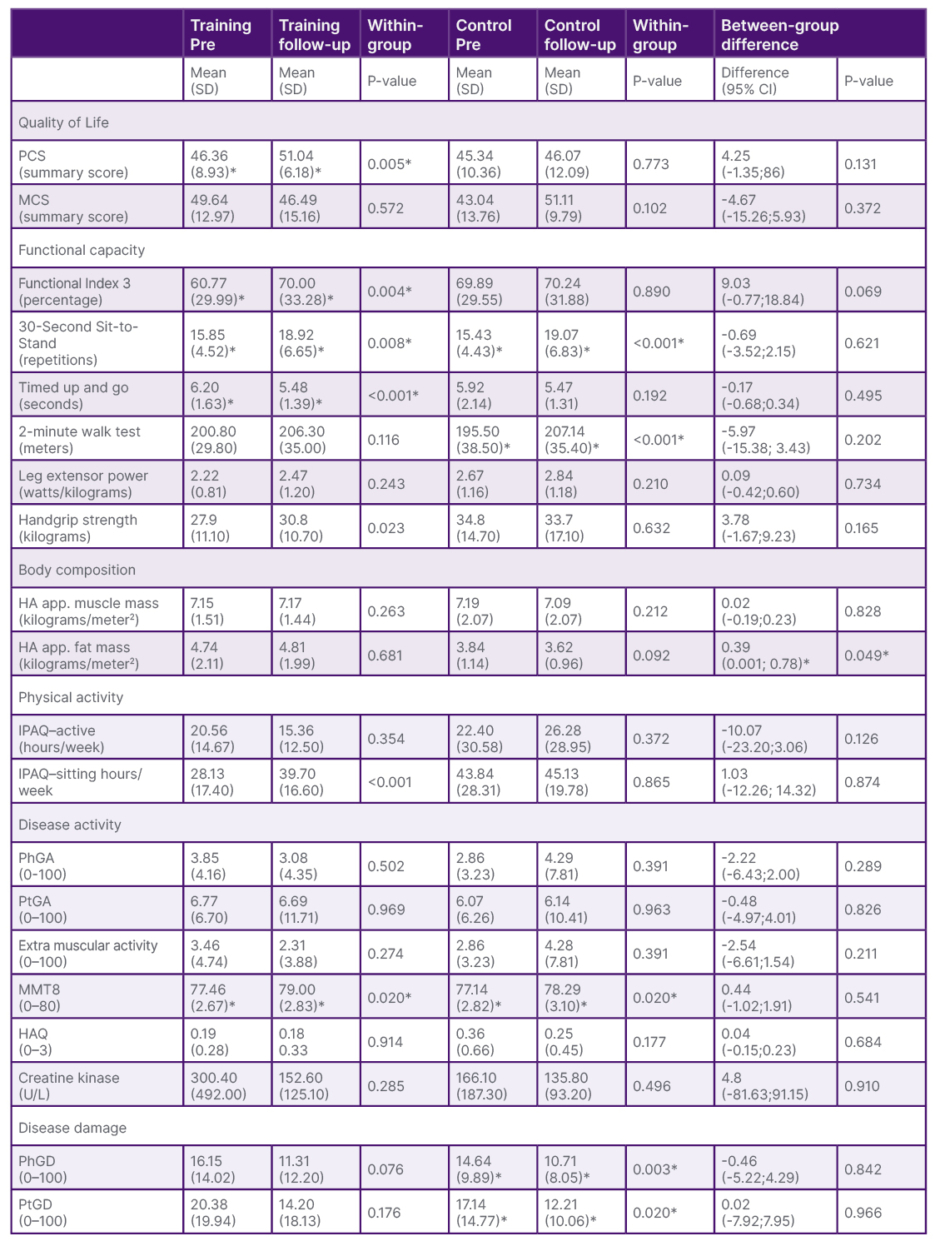BACKGROUND
Reduced muscle endurance and strength are cardinal traits in patients with myositis.1 These traits are associated with reduced quality of life (QoL),2 thus an increase in endurance and strength could potentially lead to improved QoL. The authors’ randomised controlled trial3 investigated the effects of 16 weeks of progressively adjusted high-intensity resistance training on the QoL in patients with myositis.
Increases in QoL, muscle strength, and muscle endurance were observed immediately following the 16-week intervention period for participants allocated to high-intensity resistance exercise compared to non-exercising controls. However, it is unknown to which extent these positive changes are sustained over time.
OBJECTIVE
To investigate if the effects of 16 weeks of high-intensity resistance exercise persist at the 1-year follow-up in patients with myositis.
METHODS
In the randomised controlled trial, 32 patients with myositis were allocated to either 16 weeks of high-intensity resistance training (n=15) or 16 weeks of care-as-usual (control, n=17). The present follow-up study compared outcomes from baseline (Week 0) to 1-year follow-up (Week 52). Following the 16-week intervention, both groups were given training programmes and encouraged to exercise. Twenty-seven patients completed follow-up (training, n=13; control, n=14) and were included in the per-protocol analysis.
The primary outcome was QoL (36-Item Short Form Survey, physical component summary). Secondary outcomes included functional capacity (including Functional Index 3, 30-Second Sit-to-Stand test, Timed up and Go test, 2-minute walk test, and handgrip strength), body composition by dual-energy X-ray absorptiometry (height-adjusted appendicular muscle and fat mass), self-reported levels of physical activity, and measures of disease activity and damage (including health assessment questionnaire, Manual Muscle Testing 8 [MMT8], physician and patient global activity, and physician and patient global damage).
Paired t-testing was used to perform within-group comparisons between baseline and 1-year follow-up. Further, a linear model was used to evaluate differences in between-group over time.
RESULTS
The training group demonstrated increases in physical component summary (p=0.005), Functional Index 3 (p=0.004), 30-Second Sit-to-Stand (p=0.008), Timed up and Go (p<0.001), and handgrip strength (p=0.023) at 1-year follow-up compared to baseline; while 30-Second Sit-to-Stand (p<0.001) and 2-minute walk test (p<0.001) were improved in the control group (Table 1). Reduced levels of physical activity were observed in the training group (p<0.001). In disease activity and damage measures, only MMT8 increased for the training group (p=0.020). In the control group, MMT8 (p=0.020), physician (p=0.003), and patient global damage (p=0.020) were improved at 1-year follow-up.

Table 1: Changes in quality of life, functional capacity, body composition, subjective physical activity levels and IMACS core sets from pre to 1-year follow-up in the training group and the control group.
Data are presented as group means and standard deviation. Between-group difference is presented with 95% CI in parentheses.
*Data is significant
HA app: height adjusted appendicular; IMACS: International Myositis Assessment & Clinical Studies Group disease activity; IPAQ: International Physical Activity Questionnaire; MCS: mental component summary; MMT8: Manual Muscle Testing 8; PCS: physical component summary; PhGA: physician global activity; PhGD: physician global damage; PtGA: patient global activity; PtGD: patient global damage; SD: standard deviation.
With the exception of the height-adjusted appendicular fat mass (p=0.049), no differences were observed in the between-group over time.
CONCLUSION
Patients with myositis allocated to 16 weeks of high-intensity resistance training showed sustained within-group improvements in physical QoL, functional capacity, and muscle strength at 1-year follow-up. However, these sustained improvements were not superior to care-as-usual, as the group also improved in some functional parameters and muscle strength at 1-year follow-up. No signs of increased disease activity or damage were observed at 1-year follow-up.







